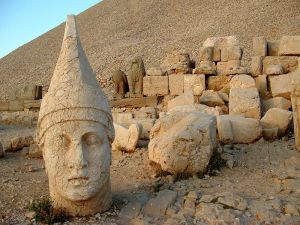Chapter 14 of the Book of Isaiah is absolutely fascinating. It’s long been interpreted as a condemnation of the rebel in the Garden of Eden. It certainly is that; Jerome’s Hebrew-to-Latin translation of the rebel’s name, Helel ben Shachar (literally, “Day Star, son of Dawn”), is the origin of the name “Lucifer.” But this chapter goes much deeper; it probably reveals more about the rebellion of the Fallen, and God’s response to it, than any other single chapter in the Bible.
On the surface, it’s a biting criticism of the king of Babylon. From our perspective, it seems natural that a Hebrew prophet would write such a thing, but we’re looking at these matters with 2,700 years of hindsight. When Isaiah lived and wrote, Babylon was a vassal state of Assyria. It was more than eight centuries after the Amorite founding dynasty of Babylon had been ended by the Kassites, a tribal people from the mountains of what is now western Iran. The Kassites continued many of the religious traditions of the Amorites, but they changed the name of the city to Karduniash. They ruled for more than four hundred years, which means the Kassites controlled Babylonia longer than any other people in history.
By the time of the Judges in Israel, about four hundred years before Isaiah, the Kassite kingdom had fallen to the Chaldeans, a Semitic people probably descended from the Amorites. But the Chaldeans never extended their control as far west as the Holy Land in the years leading up to Isaiah. Israel and Judah had more trouble with the Aramaeans, Ammonites, Moabites, Edomites, Midianites, and Philistines.
The Assyrians, based in what is now northern Iraq, emerged after the time of David and Solomon in the tenth century BC as the scourge of the Near East. Assyria destroyed the kingdom of Israel around 722 BC, flattening its capital city, Samaria, and scattering the northern tribes throughout Assyrian territory.
The Assyrians ravaged the southern kingdom, too. In the days of Isaiah and Hezekiah, Sennacherib sent his army to conquer Judah. The invaders overran most of the country, and it was only divine intervention that stopped the Assyrian army outside the walls of Jerusalem. Sennacherib withdrew to his home country, where he was assassinated by his sons. Sometimes it’s not so good to be the king.
At the time of Sennacherib’s invasion of Judah, the rise of Babylon was still more than a century in the future, in the days of Josiah, grandson of Hezekiah. So, Isaiah’s polemic against the king of Babylon, which begins in the thirteenth chapter of Isaiah, appears to be an anachronism, out of sync with the political events of the time.
When the Lord has given you rest from your pain and turmoil and the hard service with which you were made to serve, you will take up this taunt against the king of Babylon: “How the oppressor has ceased, the insolent fury ceased! The Lord has broken the staff of the wicked, the scepter of rulers, that struck the peoples in wrath with unceasing blows, that ruled the nations in anger with unrelenting persecution.” (Isaiah 14:3–6, ESV)
This text was unquestionably a prophecy of the future Babylon, an oracle of the destruction of the oppressor before Babylon became Judah’s oppressor. But clues in the chapter, mainly overlooked by Bible teachers, point to other targets of the prophet’s oracle—not just the divine rebel from Eden, but also his colleagues and their minions.
Sheol beneath is stirred up
to meet you when you come;
it rouses the shades to greet you,
all who were leaders of the earth;
it raises from their thrones
all who were kings of the nations. (Isaiah 14:9, ESV)
The Hebrew word translated “shades” is rephaim. That’s the mysterious group named in Genesis, Deuteronomy, and Joshua as the tribes who lived east of the Jordan River in the lands of Bashan, Ammon, Moab, and Edom. By the time of the judges in Israel, the Rephaim were considered the spirits of the “mighty men who were of old”—in other words, “leaders of the earth” and “kings of the nations.” Isaiah’s description is consistent with the depiction of the Rephaim in texts found at the Amorite kingdom of Ugarit. Whether the Amorite neighbors of ancient Israel knew it or not, they venerated the spirits of the half-breed giants created by the supernatural sons of God, the Watchers. This means that the role of the rebel from Eden takes on new significance.
First, we need to identify this character. Who is Helel ben Shachar? It would be easy to say “Lucifer,” and leave it at that. But, as we noted above, Lucifer is just an Anglicized version of the Latin words lux (“light”) and ferre (“to carry”). In other words, “Lucifer” is English for the Latin translation of the original Hebrew name. But who is he, really? Isaiah gives us the information we need.
How you are fallen from heaven,
O Day Star, son of Dawn!
How you are cut down to the ground,
you who laid the nations low!
You said in your heart,
“I will ascend to heaven;
above the stars of God
I will set my throne on high;
I will sit on the mount of assembly
in the far reaches of the north;
I will ascend above the heights of the clouds;
I will make myself like the Most High.” (Isaiah 14:12–14, ESV)
“Day Star” is a reference to Venus, from a Hebrew word based on a root that means “to shine.” Scholars who’ve tried to find a similar story in the religions of the ancient Near East have come up empty so far. The closest parallel is the Ugaritic myth of the war-god Attar, the male aspect of Astarte (Ishtar), who found that he was too small for the throne of the king of the gods, the storm-god Baal, who was temporarily dead. (It’s a pagan myth. It doesn’t have to make sense.) The point is that Attar was represented by Venus in the morning; Venus in the evening was believed to represent the goddess of “love,” Astarte.
Well, that doesn’t quite work. The key bit of evidence is in verse 13. The Hebrew phrase “far reaches of the north,” variously rendered in other English translations as “sides of the north,” “recesses of the north,” “remotest parts of the north,” and simply “the far north,” is yarkete tsaphon. This appears only three times in the Bible, which makes it weird. And if it’s weird, it’s important.
The other verses where we find yarkete tsaphon are in Psalm 48, where the psalmist compares God’s holy mountain, Zion, with another mountain (Zaphon—although it’s rendered “far north,” which means you have to read between the lines to grasp the wordplay of the verse: har-tziyon, yarkete tsaphon), and Ezekiel 38 and 39, the prophecy of Gog of Magog.
Why is this significant? Because Zaphon (or Saphon, or tsaphon) was the name of the mountain sacred to the storm-god Baal.
Then Valiant Baal said,
“Depart, Kothar-and-Hasis!
Hasten! Build a house indeed;
hasten! Construct a palace!
Hasten! Let them build a house;
Hasten! Let them construct a palace,
in the midst of the uttermost parts of Saphon.”
So, if the mount of assembly of the rebel in Eden is the mountain sacred to Baal, the text of Isaiah 14 can’t have been borrowed from a myth about Baal’s would-be replacement.
Why does this matter? Because Jesus specifically identified Baal the storm-god as Satan. When He was confronted by Pharisees who accused Him of casting out demons by the power of Beelzebul (“Baal the Prince”), Jesus replied, “If Satan casts out Satan, he is divided against himself. How then will his kingdom stand?” And in the Book of Revelation, Jesus told the church at Pergamum, “I know where you dwell, where Satan’s throne is.” That was a reference to the altar of Zeus, who was the Greek incarnation of the storm-god.
That gives us a simple equation: Lucifer = Baal = Satan. And since Gog (the Antichrist) is Satan’s commander-in-chief, it makes sense that he comes from yarkete tsaphon—Mount Zaphon. (That’s in Turkey, by the way. Contrary to what you’ve probably been taught, Gog and Magog have nothing to do with Russia.)
But there is more here than just a polemic against the Accuser, Satan. Isaiah gives us enough information to confirm what the Israelites’ pagan neighbors knew about Baal—that the king of their pantheon was also lord of the dead.
Note: Derek’s book Last Clash of the Titans digs into Ezekiel’s prophecy of the Gog-Magog war, and explains in depth why all of the nations mentioned by Ezekiel aside from Persia, Cush (Ethiopia), and Put (Libya) were located in Anatolia, modern-day Turkey.

Derek Gilbert Bio
Derek P. Gilbert hosts SkyWatchTV, a Christian television program that airs on several national networks, the long-running interview podcast A View from the Bunker, and co-hosts SciFriday, a weekly television program that analyzes science news with his wife, author Sharon K. Gilbert.
Before joining SkyWatchTV in 2015, his secular broadcasting career spanned more than 25 years with stops at radio stations in Philadelphia, Saint Louis, Little Rock, and suburban Chicago.
Derek is a Christian, a husband and a father. He’s been a regular speaker at Bible prophecy conferences in recent years. Derek’s most recent book is The Great Inception: Satan’s PSYOPs from Eden to Armageddon. He has also published the novels The God Conspiracy and Iron Dragons, and he’s a contributing author to the nonfiction anthologies God’s Ghostbusters, Blood on the Altar, I Predict: What 12 Global Experts Believe You Will See by 2025, and When Once We Were a Nation.





Leave a Reply
Want to join the discussion?Feel free to contribute!